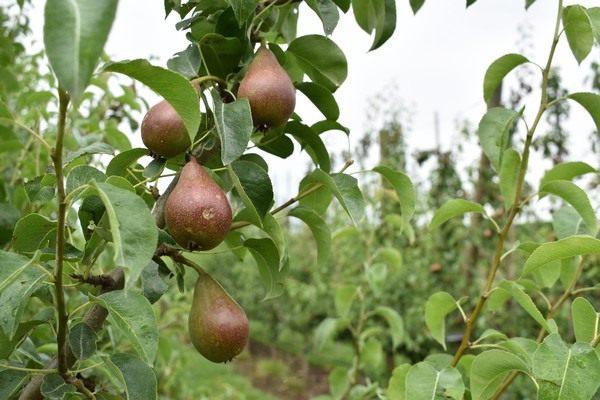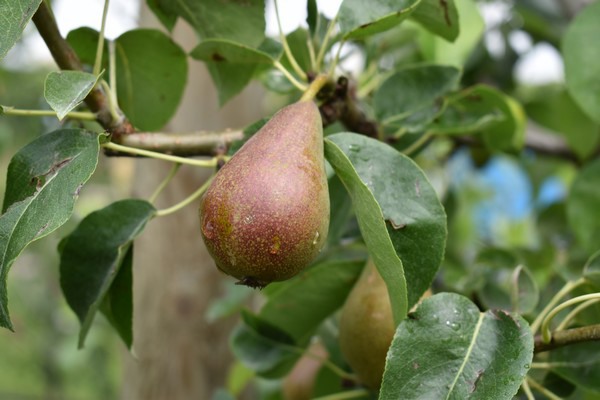Fruitconsult's, Jan Peeters, and Bernd Feenstra from Xenia Europa recently braved the Dutch rain. They inspected a Xenia pear orchard at an experimental lot in Randwijk, the Netherlands. These pears have received some hail damage. Jan, however, points out that, despite this, most of the pears did grow back a little. "That means these pears can take a bit of a beating, after all," he says, while carefully assessing their quality.
Jan Peeters (Fruitconsult) and Bernd Feenstra (Xenia Europa) in the Randwijk experimental lot.
A fruitful partnership with Fruitconsult
There have been Xenia pear trees on the Randwijk experimental lot since 2007. In 2020, this concerns 0,5 hectares of conventional and 3,000m of organic pears of this club variety. These are used for various cultivation demonstrations and studies. "We started out trying to find the best rootstock and interstems."
"Now we're mostly trying to perfect spraying schedules for growers. We're also looking at how we can best optimize these pears sizes, flavor, and production. This year, for the first time, we'll combine cultivation demonstrations with storage studies. That could prove beneficial since these two are, after all, closely linked," says Jan.
 The Randwijk experimental lot boasts 3,000m of organic and 0,5 ha of conventional Xenia pears.
The Randwijk experimental lot boasts 3,000m of organic and 0,5 ha of conventional Xenia pears.
Fruitconsult records these results, advice, and findings. These are then passed on to affiliated European Xenia farmers. That's done via newsletters and meetings. "In this way, we hope to make Xenia cultivation in Europe more uniform. The longstanding partnership with Fruitconsult also has two important advantages for us. Firstly, we can switch quickly," adds Bernd.
"That's if cultivation and market developments so dictate. Think, for example, of the phasing out of Mancozeb. Here, we're trying to jointly and quickly respond with alternatives. Secondly, we can already consider how the pear trees will behave in the future. That's because we have trees here that are almost 15 years old. We have, for instance, noticed that the older trees' still have great yields."
 Xenias are quite hardy and sustained minimal losses despite being hit by hail earlier this year.
Xenias are quite hardy and sustained minimal losses despite being hit by hail earlier this year.
Xenia pears excel in especially flavor, shelf life, and the trees' high yields. That is, according to Bernd. "Growers can turn a profit quickly. We have different cultivation studies' results and advice from Fruitconsult. With these, we hope to improve profitability further. Because a one percent loss quickly becomes one cent less for the farmer," he says.
Organic or sustainable pears
It's clear to Jan and Bernd that the Xenia offer opportunities. Not only for organic farmers but for those who wish to switch too. "These pears have much to offer," says Jan. That is partially due to its Eastern European roots. There, in 1989, they had fewer farming pesticides available. That's not only a plus point for organic growers. It helps make conventional farming more sustainable too." Bernd adds, "I prefer calling Xenia pears organic and sustainable."
The only remaining challenge is the organic Xenia pear's size. "You simply pay more for organic. So, there is usually more demand here for smaller sizes. Other than that, we distinguish ourselves here too. Along with Fruitconsult, we see how we can respond even better to organic market demands. We are doing through setting promotion, size control, and pruning," Bernd says.
 These pears have to wait until September to be picked.
These pears have to wait until September to be picked.
Sales season can be lengthened
Harvesting is still a while away. Conference pears have to be picked first. "Harvesting starts in mid-September. The season runs roughly from October to June. But, this year, we were sold out in April already. Demand's been rising faster than supply for a while now," Feenstra continues. "Sales prices have, fortunately, been stable for years. We're still expanding slowly. We don't approve all the expansion requests. If we did, pressure on prices would develop on the market. That would be a shame. Especially after all that Xenia Europa's growers, suppliers, and sales partners have invested."
Northwestern Europe, the most important market region
"Most of our pears are sold in Germany and Austria. We are expanding the fastest there. The organic market is also considerably larger there than in the Netherlands. We also sell a lot in other Northwestern European countries. These include Denmark, Finland, the UK, Ireland, and France. Business is also gradually increasing in the Netherlands."
"Quite a lot of the Class 2 fruit goes to the European market. We're trying to gain a foothold in Sweden, Spain, and Portugal as well. We work with a single sales portal. We can, therefore, keep prices stable. The goal is to maintain a healthy, durable balance between supply and demand. That's for all the different market regions," Bernd concludes.
For more information Bernd Feenstra
Bernd Feenstra
Xenia Europa BV
Tel: +31 (0) 644 496 001
Email: bernd@xenia-eu.eu
Website: www.xeniapeer.nl
 Jan Peeters
Jan Peeters
Fruitconsult
Tel: +31 (0) 653 410 921
Email: jan@fruitconsult.com
Website: www.fruitconsult.com
